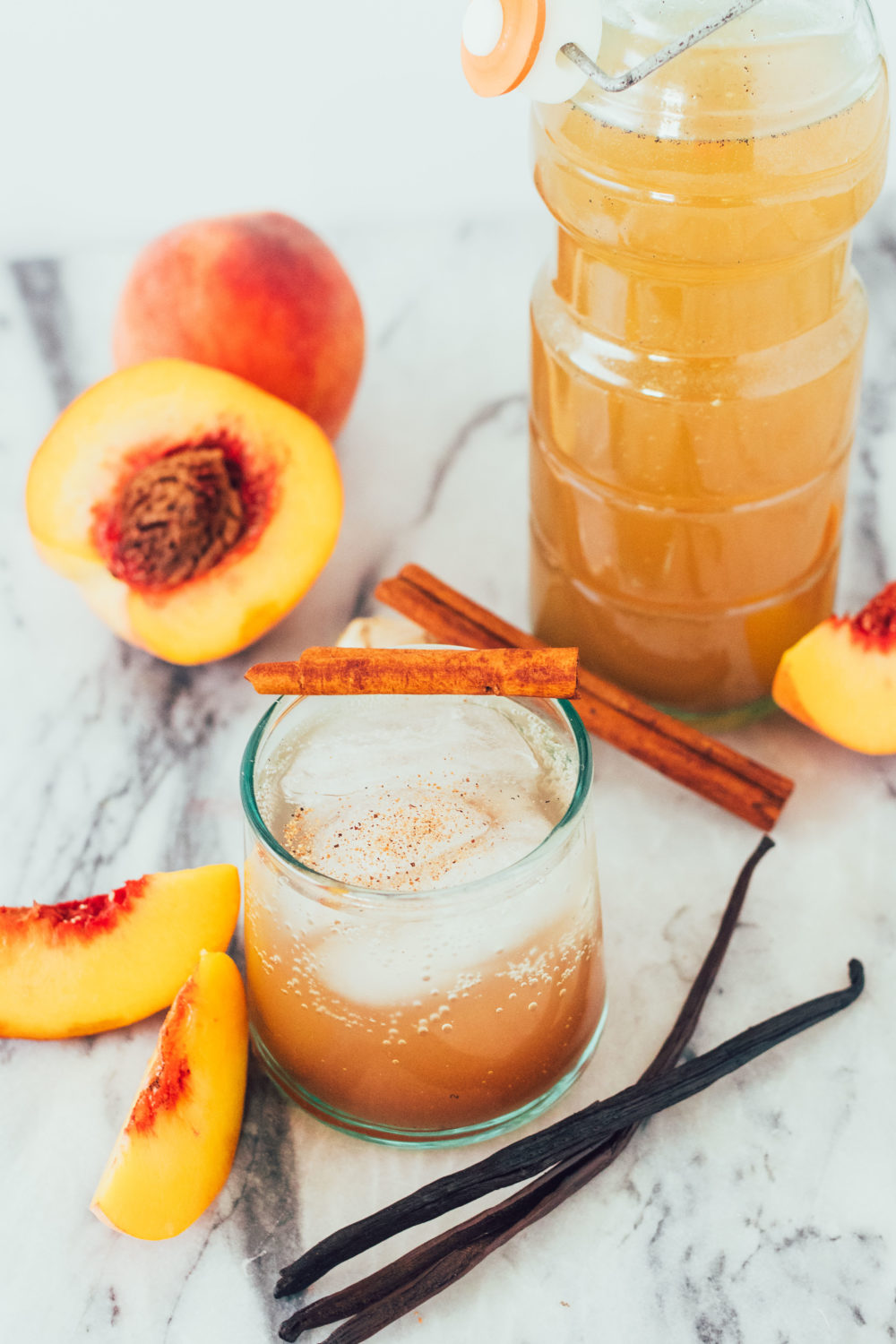

This is the second of two “shrub” (drinking vinegar) recipes I worked on this summer. For more info on shrubs and why I love them, check out this Strawberry Rosemary Drinking Vinegar recipe.
It’s a very easy recipe but make sure to read the instructions thoroughly before beginning. As with all ferments, there is a risk of mold so it’s better to be fully informed before you decide to begin!
It's free!
GET YOUR COPY
Enter your email to get a FREE printable PDF of this recipe! You'll also get my weekly letters designed to help you successfully & sustainably transition to a Paleo-style diet.
Get a printable PDF of the recipe
Spiced Stone Fruit
Active prep: 15 minutes
Total time: 30-40 days, depending on chosen methodology
Yields: 2 cups shrub concentrate or about 4 liters shrub soda
1+ c. raw apple cider vinegar (important: must say “with the mother”)
1/2 c. raw honey
3-4 large peaches or nectarines (fresh or ~16 oz. frozen)
2 inches fresh ginger, grated
5 cardamom pods, crushed to release seeds
1 vanilla bean, split
1 cinnamon stick
Optional: additional fruit juice or crushed fruit of choice (only applicable to 2nd ferment option, see below)
Equipment needed: glass quart jar, ring lid with breathable fabric like cheesecloth or nut milk bag, muddler, flip-top jar for 2nd ferment
Directions:
- Stir the apple cider vinegar (begin with just 1 cup ACV) and honey together until the honey is dissolved. This may take a few minutes so set it aside and stir occasionally while prepping the rest of the ingredients.
- Clean and dry the peaches. I recommend using a fruit & veggie wash just to be sure nothing is going to compete with the fermentation process. Cut into small pieces and add them to a quart-sized mason jar, along with the grated ginger, cinnamon, cardamom, and vanilla bean.
- Using a muddler or similar apparatus, press down onto the peaches until they are very mushy and the cardamom and vanilla are a bit broken up. Add the cinnamon stick down into the mixture.
- Pour the ACV/honey mixture over top and stir. If there is more than an inch of space left at the top, add additional ACV in until it’s nearer the top and mostly covering the fruit.
- Cover the jar with cheesecloth and the ring seal (as shown). Coffee filters or even paper towel also work for this. Set in a cool, dark-ish place (anywhere away from direct sunlight is good) where the temperature ranges from 65F-75F ideally.
- Leave for 30 days, checking every couple of days near the beginning to stir and tuck any fruit under the liquid. Both apple cider vinegar and honey are great preservatives so if you are diligent in tucking the fruit under near the beginning, you shouldn’t experience any mold issues. The surface will darken slightly but that’s normal.
- After 30 days, strain the solid pieces out using cheesecloth or a nut milk bag (you want a very fine strainer for this so no pieces are left). Discard the solid pieces. The liquid strained out is the “shrub.”
- The shrub can be left at room temperature nearly indefinitely due to how slow the ferment happens. If you do not wish for it to continue to ferment (since there’s a very gradual decrease in sweetness with this process), you can store the shrub in the fridge.
- You have a few options at this point:
- Add 1-2 teaspoons to 8 oz. warm water right after waking.
- Add a 1+ tablespoons of shrub to your bubbly beverage of choice (I use LaCroix or Target’s Simply Balanced sparkling waters). Keep in mind that if your added beverage is unsweetened, this will not be a very tart/not-sweet drink.
- Start a 2nd ferment with the shrub as a base.
- To 2nd ferment the shrub, use the following ratios for a 32 oz. flip-to jar:
- 1/2 cup of shrub
- 1 cup of fruit juice or crushed fruit
- 2 cups filtered water
- Directions: add the shrub, fruit juice, and filtered water to the jar. Seal and gently invert to shake the ingredients together. Leave on the counter for 7+ days to ferment and get fizzy. You will want to check on it after 2 days to “burp” (open to release gasses). Continue to burp every day thereafter to prevent the internal pressure from building too high. Taste after 5 days to gauge the sweetness and level of fizz. Leave fermenting longer for less sweetness and more tart flavor.
Note: similar to kombucha, you can save some of the 2nd ferment to create new on-going brews, but while it will be probiotic in nature, the ACV content/benefit will diminish with each consecutive brew.







